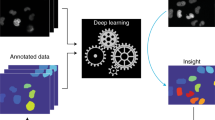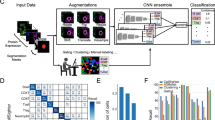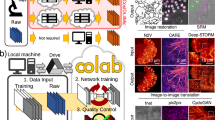Abstract
Deep learning is transforming the analysis of biological images, but applying these models to large datasets remains challenging. Here we describe the DeepCell Kiosk, cloud-native software that dynamically scales deep learning workflows to accommodate large imaging datasets. To demonstrate the scalability and affordability of this software, we identified cell nuclei in 106 1-megapixel images in ~5.5 h for ~US$250, with a cost below US$100 achievable depending on cluster configuration. The DeepCell Kiosk can be downloaded at https://github.com/vanvalenlab/kiosk-console; a persistent deployment is available at https://deepcell.org/.
This is a preview of subscription content, access via your institution
Access options
Access Nature and 54 other Nature Portfolio journals
Get Nature+, our best-value online-access subscription
$29.99 / 30 days
cancel any time
Subscribe to this journal
Receive 12 print issues and online access
$259.00 per year
only $21.58 per issue
Buy this article
- Purchase on Springer Link
- Instant access to full article PDF
Prices may be subject to local taxes which are calculated during checkout

Similar content being viewed by others
Data availability
All data that were used to generate the figures in this paper are available at https://deepcell.org/data and at https://github.com/vanvalenlab/deepcell-tf under the deepcell.datasets module.
Code availability
We used Kubernetes and TensorFlow, along with the scientific computing stack for Python. A persistent deployment of the software described can be accessed at https://deepcell.org/. All source code, including version requirements and explicit usage, is under a modified Apache license and is available at https://github.com/vanvalenlab. Detailed instructions are available at https://deepcell-kiosk.readthedocs.io.
Change history
13 January 2021
A Correction to this paper has been published: https://doi.org/10.1038/s41592-021-01059-w
References
Ouyang, W. et al. Analysis of the Human Protein Atlas Image Classification competition. Nat. Methods 16, 1254–1261 (2019).
Falk, T. et al. U-Net: deep learning for cell counting, detection, and morphometry. Nat. Methods 16, 67–70 (2019).
Van Valen, D. A. et al. Deep learning automates the quantitative analysis of individual cells in live-cell imaging experiments. PLoS Comput. Biol. 12, e1005177 (2016).
Schmidt, U., Weigert, M., Broaddus, C. & Myers, G. Cell detection with star-convex polygons. In Medical Image Computing and Computer Assisted Intervention—MICCAI 2018 (eds. Frangi, A. F. et al.) 265–273 (Springer International Publishing, 2018).
Moen, E. et al. Accurate cell tracking and lineage construction in live-cell imaging experiments with deep learning. Preprint at bioRxiv https://doi.org/10.1101/803205 (2019).
Anjum, S. & Gurari, D. CTMC: Cell Tracking with Mitosis Detection dataset challenge. in Proc. IEEE/CVF Conf. Computer Vision and Pattern Recognition (CVPR) Workshops 982–983 (2020).
Gómez-de-Mariscal, E. et al. DeepImageJ: a user-friendly plugin to run deep learning models in ImageJ. Preprint at bioRxiv https://doi.org/10.1101/799270 (2019).
Ouyang, W., Mueller, F., Hjelmare, M., Lundberg, E. & Zimmer, C. ImJoy: an open-source computational platform for the deep learning era. Nat. Methods 16, 1199–1200 (2019).
von Chamier, L. et al. ZeroCostDL4Mic: an open platform to simplify access and use of deep-learning in microscopy. Preprint at bioRxiv https://doi.org/10.1101/2020.03.20.000133 (2020).
McQuin, C. et al. CellProfiler 3.0: next-generation image processing for biology. PLoS Biol. 16, e2005970 (2018).
Haberl, M. G. et al. CDeep3M—Plug-and-Play cloud-based deep learning for image segmentation. Nat. Methods 15, 677–680 (2018).
Emami Khoonsari, P. et al. Interoperable and scalable data analysis with microservices: applications in metabolomics. Bioinformatics 35, 3752–3760 (2019).
Novella, J. A. et al. Container-based bioinformatics with Pachyderm. Bioinformatics 35, 839–846 (2019).
Capuccini, M. et al. On-demand virtual research environments using microservices. PeerJ Comput. Sci. 5, e232 (2019).
Peters, K. et al. PhenoMeNal: processing and analysis of metabolomics data in the cloud. GigaScience 8, giy149 (2019).
Schindelin, J. et al. Fiji: an open-source platform for biological-image analysis. Nat. Methods 9, 676–682 (2012).
Sofroniew, N. et al. napari/napari: 0.3.5. Zenodo https://doi.org/10.5281/zenodo.3900158 (2020).
Altschul, S. F. et al. Gapped BLAST and PSI-BLAST: a new generation of protein database search programs. Nucleic Acids Res. 25, 3389–3402 (1997).
Keren, L. et al. A structured tumor-immune microenvironment in triple negative breast cancer revealed by multiplexed ion beam imaging. Cell 174, 1373–1387 (2018).
Acknowledgements
We thank numerous colleagues including A. Anandkumar, M. Angelo, J. Bois, I. Brown, A. Butkovic, L. Cai, I. Camplisson, M. Covert, M. Elowitz, J. Freeman, C. Frick, L. Geontoro, A. Ho, K. Huang, K. C. Huang, G. Johnson, L. Keren, D. Litovitz, D. Macklin, U. Manor, S. Patel, A. Raj, N. Pelaez Restrepo, C. Pavelchek, S. Shah and M. Thomson for helpful discussions and contributing data. We gratefully acknowledge support from the Shurl and Kay Curci Foundation, the Rita Allen Foundation, the Paul Allen Family Foundation through the Allen Discovery Center at Stanford University, the Rosen Center for Bioengineering at Caltech, Google Research Cloud, Figure 8’s AI For Everyone award, and a subaward from NIH U24-CA224309-01.
Author information
Authors and Affiliations
Contributions
D.B., W.G. and D.V.V. conceived the project; D.B., W.G., E.O. and D.V.V. designed the software architecture; D.B., E.O. and W.G. wrote the core components of the software; D.B., E.M., M.S., E.B., V.V., B.C., E.O., W.G. and D.V.V. contributed to the code base; T.K. and E.P. collected data for annotation; E.M., M.S., N.G., D.B., W.G. and D.V.V. wrote documentation; D.B., E.M., W.G. and D.V.V. wrote the paper; D.V.V. supervised the project.
Corresponding author
Ethics declarations
Competing interests
The authors have filed a provisional patent for the described work; the software described here is available under a modified Apache license and is free for non-commercial uses.
Additional information
Peer review information Nature Methods thanks Ola Spjuth and the other, anonymous, reviewer(s) for their contribution to the peer review of this work. Rita Strack was the primary editor on this article and managed its editorial process and peer review in collaboration with the rest of the editorial team.
Publisher’s note Springer Nature remains neutral with regard to jurisdictional claims in published maps and institutional affiliations.
Supplementary information
Supplementary Information
Supplementary Notes 1–8. This Supplemental Information describes in further detail the software architecture of the DeepCell Kiosk, presents all our benchmarking data, and outlines the reasoning behind several of our design choices. Because we use terminology that is common in the cloud computing literature but may be unfamiliar to readers, we have included a glossary of common terms.
Rights and permissions
About this article
Cite this article
Bannon, D., Moen, E., Schwartz, M. et al. DeepCell Kiosk: scaling deep learning–enabled cellular image analysis with Kubernetes. Nat Methods 18, 43–45 (2021). https://doi.org/10.1038/s41592-020-01023-0
Received:
Accepted:
Published:
Issue Date:
DOI: https://doi.org/10.1038/s41592-020-01023-0
This article is cited by
-
Artificial intelligence applications in histopathology
Nature Reviews Electrical Engineering (2024)
-
Vascularized organoid-on-a-chip: design, imaging, and analysis
Angiogenesis (2024)
-
Decoding the tumor microenvironment with spatial technologies
Nature Immunology (2023)
-
Deep learning-based image analysis identifies a DAT-negative subpopulation of dopaminergic neurons in the lateral Substantia nigra
Communications Biology (2023)
-
Deep learning-enabled segmentation of ambiguous bioimages with deepflash2
Nature Communications (2023)



